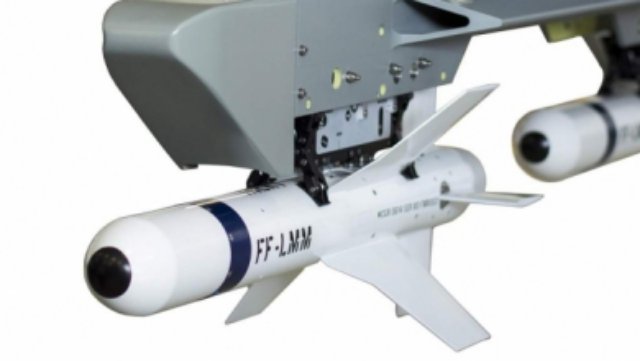 Thales has developed a ready-for-market precision-guided bomb based on its Lightweight Multi-role Missile (LMM) designed for use on small unmanned air systems.
Thales has developed a ready-for-market precision-guided bomb based on its Lightweight Multi-role Missile (LMM) designed for use on small unmanned air systems.
The weapon, known as the FreeFall LMM or FFLMM, is a 70-cm (28-in.) long, 6-kg (13-lb.) glide bomb with many of the common components used on the LMM missile developed by Thales to meet the U.K. Defense Ministry’s Future Air-to-Surface Guided Weapon (Light) (FASGW (L)) requirement.
The FFLMM was developed by Thales at its missiles division based in Belfast, Northern Ireland, but the company has partnered with Textron, who will act as the U.S. market partner in the weapon’s development. Textron will market the weapon as the Fury, alongside its heavier G-CLAW glide bomb.
“The growth in unmanned aerial systems for the intelligence, surveillance and reconnaissance (ISR) role has been phenomenal, but many of these systems have no way of dealing with fleeting or time-sensitive targets,” says Ricky Adair, director of sales and marketing for the missiles division at Thales. “Using our development work with LMM, we have created a weapon with a high level of maturity, but a low cost of integration.”
The weapon has been in development for around 18 months, and Thales has already completed a series of flight trials and drops from an unnamed Textron unmanned platform outside the U.K.
In simple terms, FFLMM uses the body and control actuators of the 15-kg LMM but removes that weapon’s rocket motor and associated components. The internals are re-packaged and Thales has added INS and GPS navigation as well as a semi-active laser guidance that replaces the beam-riding system used on the LMM. Four enlarged fins increase lift, while overall weight is reduced to 6 kg. The LMM’s 2-kg warhead also is retained, but the company also is looking at adding an airburst fuse that would be selectable in-flight.
“There are many market opportunities for a weapon like this,” Adair said, “We can fit these on UAVs or unmanned helicopters or a larger number on a manned aircraft or helicopter.”
An unpowered variant of the LMM was considered earlier in the program, but it used a complex set of folding wings that have been discarded in the FFLMM. The weapon is being revealed at the Farnborough air show for the first time and will be hanging off the wings of the Britten Norman Defender and the Beechcraft AT-6 Texan in the static display.
Last month, the U.K. Defense Ministry awarded Thales a £48 million ($82 million) contract to complete development work and begin manufacture of the LMM weapon, which is envisaged for integration with the new AgustaWestland AW159 Wildcat helicopter for the Royal Navy.
The company also believes the weapon will find its way into ground combat vehicles and small naval boats and ships. Firing trials from the Wildcat are expected in two years, and LMM is expected to enter service around 2020, roughly at the same time as its large, MBDA-built sibling, the FASGW (Heavy), which received the go-ahead from the British and French governments earlier this year.
